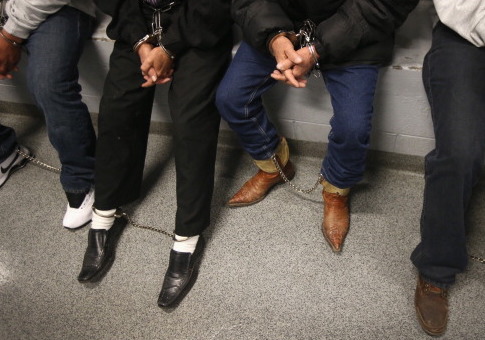After rising precipitously compared to Obama-administration lows, deportations through an important ICE program have plateaued, new data show.
This conclusion comes from a new analysis from the Transactional Records Access Clearinghouse (TRAC), a Syracuse University-based project that organizes and analyzes government data. The Secure Communities Program is, according to TRAC, "widely portrayed as the cornerstone" of ICE's expanded enforcement efforts under President Donald Trump.
However, since Trump restarted the program shortly after taking office, deportations under the SCP have tapered off, stabilizing at around 6,200 a month.
The SCP facilitates coordination between state/local enforcement and ICE. When a person is booked by state or local officers, his fingerprints are routinely taken and sent to the FBI. In turn, the FBI hands that fingerprint information over to ICE, which uses it to determine if that individual is subject to deportation. If so, ICE will initiate further deportation proceedings against the person held in custody.
The program began in 2008, and carried over through the first 6 years of President Barack Obama's administration. By 2014, SCP accounted for about 75 percent of all deportations from within the interior. Obama temporarily suspended the SCP in 2014, replacing it with the Priority Enforcement Program, which had a more restricted set of deportation priorities, focusing primarily on serious criminal offenders.
President Trump issued an executive order shortly after being sworn in overturning the Obama priorities and expanding the number of people whom ICE would target for deportation. As part of that order, Trump brought the PEP to an end, reinstating the SCP.
ICE deportations under the SCP promptly rose, in line with other deportation trends. There were 18 percent more SCP deportations in 2017 than PEP deportations in 2016, and 12 percent more SCP deportations in 2017 than PEP deportations in 2015. As of October of 2017, month-to-month rates of SCP deportation had more or less leveled off.
Furthermore, SCP deportations under Trump are in fact still lower than those through the same program under Obama. There almost 19 percent more SCP removals in 2012 as compared to 2017. Indeed, there were 85 percent more removals from the interior overall.
TRAC's data also provides valuable insight into who is being deported by ICE under Trump's expanded deportation priorities. Because the SCP is focused on individuals who have been arrested by law enforcement, the reasons for those individuals' deportations can be tied to the offense with which they were charged. As such, SCP deportations show who is being targeted for deportation, and how that targeting compares to priorities under the Obama administration.
Individuals are most frequently deported under the SCP for non-violent, often minor crimes, TRAC found. More than 2,300 people were deported under the SCP for traffic offenses between February and October of 2017, a 138 percent increase compared to the previous year. "Public disorder crimes," licensing violations, flight to avoid prosecution or confinement, and liquor violations all also saw three digit increases.
By contrast, the number of individuals deported for serious, violent offenses, generally either fell or stayed constant. Similar numbers of individuals in 2016 and 2017 were deported for assault, sexual assault, and homicide, among other offenses.
